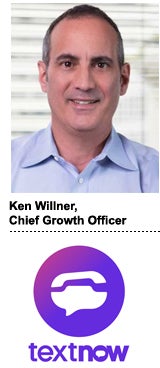“The Sell Sider” is a column written by the sell side of the digital media community.
TextNow, a free text, voice and video calling app, is on track to hit $100 million in revenue this year, up from $62 million in 2020. The company is profitable.
Fun fact, most of that revenue comes from advertising.
The value exchange is “pretty explicit in our case,” said Ken Willner, chief growth officer at TextNow, which has roughly 10 million monthly and 2 million daily active users.
“Users get value – a free phone service – in exchange for viewing ads,” Willner said. “And as long as that is transparent, which we always make sure is the case, this model has a strong appeal to our younger Gen Z users.”
Although TextNow also offers a paid ad-free option, the ad-supported version is way more popular.
“We’ve found that our younger users gravitate towards not having to dig into their pocket,” Willner said. “They understand that their phone service is free because it’s being subsidized by marketers.”
TextNow was founded in 2009 by two then-university students in Canada trying to save money on their phone bill. “So they developed an app to deliver those services for free,” Willner said. “Our CEO [Derek Ting] has a thing he likes to say, which is that we work harder to make things free, which is sort of counterintuitive in the wireless space where it always feels like carriers are working harder to charge you for stuff.”
Willner spoke with AdExchanger.
AdExchanger: Who are your users?
KEN WILLNER: Our demographics tend to skew younger. Our users are digitally savvy, they have a cord-cutting mentality and they see us as a viable alternative to a regular, standard wireless carrier. Roughly 65% of our users are under 35.
Around 20% of our audience use our service to have a dedicated phone number to support some form of business, like a side hustle. But the majority of users rely on us for free phone services.
There’s an underserved population in the US that doesn’t have access to telecommunications services, and that’s become even more true over the past nearly two years of COVID. People lost their jobs and they need basic phone services to access health care, social services or to search for a job.
Do you sell programmatically?
We participate on all the major exchanges and we’re tied into all the SSPs and DSPs you’d know, like any digital publisher out there. Programmatic is the bulk of what we do.
But in addition to programmatic, we recently started working directly with agencies and brands. In addition to standard IAB ad units, we also have native advertising capabilities that are unique to us. For example, advertisers can sponsor a subset or all of our users in a targeted way and get exposure on a splash page or a loading page. It’s the “brought to you by” concept.
One of the ways we differentiate is that unlike a lot of other apps or media properties, the advertiser isn’t competing with other content on a page. Our users treat us as a utility, so they’re highly engaged. They’re calling, they’re texting and the advertiser is front and center in a brand safe, high-visibility environment.
How do you bundle your inventory?
Direct is new for us. We’ve only been doing it for about eight months. But our ideal state will be to have a mix of both direct advertisers and advertisers buying programmatically.
If we’re working with an advertiser on the open exchange, we might use that as an opportunity to try and offer them something unique they can do with us directly, and vice versa.
Do you guys do the mobile header bidding thing?
We’re believers, but we don’t do it yet – “yet” being the operative word. We intend to offer it, although at the moment we have a waterfall process.
Do you collect user data?
We have first-party and third-party data that we can use to help marketers with specific campaigns. But we’re really careful, especially with first-party data. A lot of what we collect we only use for our own purposes.
We capture a fair amount of explicit data through in-app surveys to help brands get feedback on a campaign or learn about our users. Because we’re an app and a telecom service, advertisers can reach our users through push messaging, in-app messaging and SMS.
We also capture a bunch of app usage data. We recently started working with a DMP to help us understand more about our users, like the kind of car they drive, for example, or the type of soda they prefer to drink.
How do you encourage retention and cut down on churn?
That’s a major focus for us right now.
We’ve started working with CRM tools to make sure we’re managing our user relationships properly, and we’re partnering with loyalty programs. For example, McDonald’s had a promotion a few months ago where they were giving out free fries to people who downloaded their app, and we sent out messaging to our users to help encourage downloads.
We’re always looking for ways to marry monetization with value for users.
How are you dealing with Apple’s ATT changes?
We took a hit like everybody, but we’re fortunate that when iOS 14.5 came out, it didn’t hit us hard because most of our users, around 70%, are on Android.
But since then, we’ve seen some rebound on iOS. I’d speculate that advertisers are getting at least a little more comfortable with the idea that they’re just not going to have the same level of tracking on iOS anymore.
This interview has been edited and condensed.














